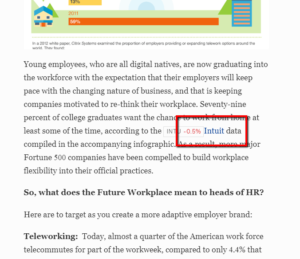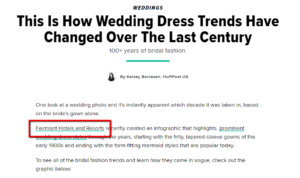
Generally speaking, a good link has a few key attributes:
- Domain relevance
- Semantic relevance
- High authority source
- Prominently placed
- Provides real value to users
- On a page with no or few other outbound links
When an SEO or content marketer is doing link building work, this is generally the criteria we’re working towards and how the anatomy of a link is broken down. It’s also the criteria I work towards on my website.
There are other great articles on this subject, and ones that go deep into the theory of link building and the technical implementation of links that certainly play their part in how links pass equity. However, I wanted to keep this guide focused on the surface level of links – things that you can spot quickly and develop a sense for when doing link building.
In the vast majority of cases, building links with this set of criteria will drastically improve your contents ability to rank for competitive keywords and increase organic traffic. Understanding these criteria also helps to develop a sense for when there are bad links in a profile and spot domains to stay away from.
So let’s break the factors down one-by-one:
Domain Relevance
In order to improve the ranking performance of a target URL or domain, it makes sense that the linking domain (i.e. the domain linking to you) should be one that largely focuses on the same type of content as you do. This is a pretty strong signal to search engines that your content is going to be of interest to those users and therefore, more likely someone will actually click.
Historically, when search engines weren’t as smart as they are today, relevance wasn’t as big a deal. This is largely why you could write an article on Ezine ( : | ), strengthen your domain and improve the likelihood that you’ll rank. In fact, that’s what I did for nearly a year:
Today, it’s easy to see and outright logical that search engines would move towards weighting links with more value if they come from domains that are more relevant to your readers.
Semantic Relevance
Semantic relevance, i.e. the context of the content surrounding the link to your domain, has been a determining factor of value for a long while.
Like domain relevance, the copy and topical nature of the page where your link is needs to make sense. For example, if your money management blog gains a link back from Forbes.com because of a piece of research you published about the average debt of millennial’s, it’s likely the writer of that article will be also include various insights into debt, reasons for it, the debt of other age groups. etc. This builds up the context surrounding the link that search engines then understand and pass topical value through to your domain and research.
This then has a knock-on effect to your rankings. If you think like a search engine who then receives a query for ‘how do I manage credit card debt’, they know your website is one that produces that sort of content and a relevant, authoritative domain has linked to you. If you have content targeting that query already, it makes sense for them to assume you know what your talking about so will return your result and rank you higher than they would have previously. Of course there are other factors at play, but in isolation…
On the flip-side, consider if Forbes.com had written an article on upcoming small business trends but linked through to a cats meme domain. Although many, many people like cat memes, it’s unlikely that this is a natural fit for the majority of people reading this article (at least, not right now), and therefore, this link, although from the same authoritative source as our money management blog scenario, won’t pass the same level of authority and impact the cat memes domain to the same degree.
Forbes.com link I got for an old client I worked with, surrounded by content all about workspaces
High authority source
This is probably one of the oldest known metrics within link building and concerns itself with the strength of the linking root domain (LRD). One of the absolute best metrics to understand the quality of a domain and its ability to pass value is Majestic’s Trust Flow. Although other metrics are still extremely useful and popular, such as Moz’s Domain Authority which historically most of my clients have naturally used, Trust Flow is able to isolate authority and focuses on the inter-connectivity of link quality passing through all domains in its matrix.
Essentially this means that if you imagine all domains as a messy spider web, with domains linking to each other and connections flowing between them, search engines are able understand which of them have the strongest links coming to them based on the strength of the links going to it, and so forth.
Therefore, by getting links from these domains, you put yourself in the same neighbourhood and this authority compounds, passing to your domain. Search engines can then easily associate you as one of the domains in this space which is a central part of this inter-connectivity and rank you accordingly.
Prominently placed
When building links, you’re really aiming to increase the likelihood that people are going to come through to your website as referral traffic, and this is how search engines think. Links that are more likely to be clicked and are placed in highly visible places on the page or naturally as part of the course of reading a piece of content, are more likely to receive that click and therefore receive more link equity.
HuffPost linked to our piece smack bang at the start of the article
Like above, there’s no doubt to users or search engines why this article and corresponding piece of content on weddings exists. Of course, there’s very little we can do to actually control where or sometimes even if a journalist will mention you/the client in their article, but you can certainly point to it in your outreach or aim to put the brand at the heart of the story so there’s no possible way a journalist could write the article without mentioning the ‘who’.
This, nearly always, leads to prominence.
Provides real value to users
There’s lots of way this criteria can go, and honestly in a lot of instances it’s aspirational, but you can most often make the argument that if what you’ve produced or the story your publishing is of interest, the company has value to those interested in it.
However, there are instances when the content you produce and publicise can actually provide value.
For instance, calculators, games, tools, interactive information, etc. all of these are forms of content that will be of value to the person reading the article you’re featured in.
In my experience, there is a fine balancing act to be made here as your piece needs to not only be useful and offer value to a user, but it needs to offer value to a journalist as well, and here we’re talking not of the practical sort.
The DailyMail featured our tool offering users an insight into the best ROI changes they could do to their home
The piece above struck that balance. By picking to create a tool on a topic that journalists want to talk about and had a surprising outcome (did you know converting your garage costs less and earns you more money than doing a loft extension!?) a journalist has their headline and we have a link to our valuable tool.
Few or no other links around
Historically, webmasters were taught that no page on your website should have over 100 links on it. The reason being that the link equity being funneled from that page was being split between all of those links and past that point, the link value becomes so minuscule that there’s no point.
Today, the algorithm is likely still to work in a similar fashion (although cross-referenced with a bunch of others), but the premise still loosely remains. It’s better to be a well-placed, prominent link on a page than one in a sea of other links – one no more likely to receive a click than another.
See, directories:
Now, there’s nothing really wrong with having a link on the page above if you’re a fencing and decking business in the UK. In fact, if you were my clients, I’d see if we could put you here, but I wouldn’t dress this up as a good link. It’s relevant, which is very high on my list of priorities, but I wouldn’t be expecting P1 rankings from it.
As explained above, links on these pages just don’t offer the value to a user compared to one at the heart of a story, and it makes logical sense for their to be a division of link equity here because they essentially cancel each other out.
I really hope you’ve enjoyed the post and have found it useful. If there’s any questions at all, please leave a comment and let me know!






4 Responses
Great read. Why Semantic Relevance is overlooked is beyond me, it’s such an obvious point and basically the first step of machine learning.
How about an article on Machine Learning & SEO? Understanding how machine learning works would be a great insight into SEO and link building.
Very good insights as usual. Topical relevancy is extremely important for SEO linkbuilding, because it provides for a better user experience and because it’s one of many ways to devalue spam links.
[…] I’ve discussed in a post before on link anatomy, any successful link building activity should focus on the […]
[…] I’ve discussed in a post before on link anatomy, any successful link building activity should focus on the […]